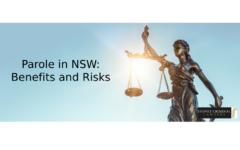Parole in New South Wales: What Are the Benefits and Risks of Granting Parole?

A recent decision to grant parole to a murderer who attempted to sexually assault a woman when he was last paroled has many up in arms.
But while the decision by the NSW State Parole Authority to release convicted murderer and sexual offender Terrence John Leary is seen by many members of the public and the mainstream media as unjustifiably placing the community at risk, others believe it is in the public interest as it enables him to be closely supervised while integrating back into the community, rather than released without supervision at the end of his full sentence.
So, who is Terrence Leary? What is parole? Why has he been paroled? And what are the potential benefits and risks of releasing a prison inmate to parole?
The Story So Far
Then 33-year old Terrence Leary snuck into the house of 17-year-old Vanessa Hoson in 1990, and beat her to death because she refused to have sex with him.
He was convicted for the murder and released on parole after spending 22 years behind bars.
Shortly after his release in 2013, Leary attempted to sexually assault a 30-year-old woman in Hunters Hill. He was found guilty of the offence and given a full term prison sentence of 15-years.
Having now served nearly 11 years of the sentence and being eligible for release on parole, on 29 August 2024 the NSW State Parole Authority (SPA) determined that, with strict supervision and a laundry list of conditions, Leary should be released on parole as it would be “conducive to the safety of the community” to release him now under supervision rather than unsupervised in four years after his full term has been served.
SPA chairperson Geoffrey Bellew SC acknowledged that Leary’s release was “inevitable” and, weighing all factors, ordered his release to conditional liberty.
Offending on parole
So, what is parole?
Prison sentences in New South Wales will generally either have a fixed term – which must be set for sentences of six months or less – or a non-parole period and parole period.
A court that imposes a sentence of over six months can only decline to set a parole and non-parole period in extremely limited circumstances.
A non-parole period is the time a person must spend in prison before being eligible to apply for release on parole.
The parole period is not to exceed one-third of the non-parole period unless ‘special circumstances’ are present which justify an extended period of supervision on parole.
Those who receive a full-term prison sentence (non-parole plus parole period) of three years or less will have a right to release on parole.
Those whose full-term prison sentence is longer than three years will need to be assessed by the SPA, which will determine whether he or she will be released on parole.
What are the conditions of parole in NSW?
The standard conditions of parole in New South Wales include:
- To be of good behaviour for the duration of the parole period,
- Not to commit any offence while on parole, and
- To adapt to normal, lawful community life.
In the event a supervision condition is imposed with parole, the parolee must also:
- Report to a Community Corrections Officer or a Community Corrections office within 7 days of release,
- Report to a CCO at the pre-set times and locations,
- Comply with reasonable directions from the CCO regarding living details (eg residential address, participation in programs, employment, lifestyle, drug/alcohol use),
- Comply with CCO directions,
- Permit the CCO to attend place of residence,
- Notify a CCO of any change of address, and
- Not leave New South Wales without permission from the CCO, and
- Not leave Australia without permission from the SPA.
Parolees can be subject to electronic monitoring as well as drug/alcohol testing.
Considerations when determining parole
The SPA will consider a range of competing factors when determining whether to grant parole.
The SPA is prohibited from granting parole unless it is satisfied, on the balance of probabilities, that such a grant is ‘appropriate in the public interest’.
In making its decision, the SPA must have regard to a range of matters including:
- The need to protect the safety of the community,
- The need to maintain public confidence in the administration of justice,
- The nature and circumstances of the offence to which the offender’s sentence relates,
- Any relevant comments made by the sentencing court,
- The offender’s criminal history,
- The likelihood of the offender being able to adapt to normal lawful community life,
- The likely effect on any victim of the offender, and on any such victim’s family, of the offender being released to parole, and
- Any report in relation to the granting of parole to the offender that has been prepared by or on behalf of the Probation and Parole Service.
What are the benefits and risks of releasing an inmate on parole?
The main benefits of parole are that it provides an incentive for inmates to behave well and complete rehabilitation programs, which in turn creates a positive prison environment, reduces the risk of reoffending both inside prison and after release, and increases the likelihood he or she will transition into becoming a law-abiding and productive member of the community.
The regime’s requirement for supervision ensures there is not only monitoring to reduce the likelihood of reoffending, but support systems to enhance the prospects of the parolee staying away from crime and being steered towards a positive and gainful lifestyle.
Of course, the main risk associated with a person being released on parole is that he or she will, like Leary, reoffend during the period of parole.
However, those in favour of the parole system point to the fact that the vast majority of inmates – save for those given a full term sentence of life imprisonment – will someday be released into the community, and in the absence of parole will be less likely to engage in rehabilitation programs and be able to transition into a positive lifestyle.







